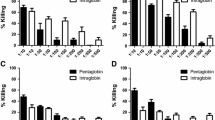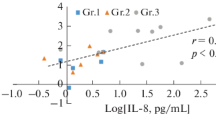Summary
The complement-mediated opsonic activity (CMOA) in intra-abdominal exudates collected during laparotomy from peritonitis patients was examined by anin vitro phagocytic bactericidal assay. It was found that infected intra-abdominal exudates barely promoted detectable killing ofEscherichia coli 01 by polymorphonuclear leukocytes. Only the minority of bacteria recovered by differential centrifugation from the infected exudates had C3 on their surfaces. Such bacteria were not optimally opsonizedin vivo, whereas they became fully coated with C3 during a brief incubationin vitro in normal human serum. The low level of CMOA in the peritoneal fluid paralleled a depletion of complement in the peripheral blood. Thus, in cases complicated by sepsis with gram-negative bacteria, the CMOA in the blood was extremely low. These data suggest that the high susceptibility of the peritoneum to infection by gut flora, despite the normal phagocytic response, may be partly explained by the low local level of functional complement which is inadequate for optimal opsonization of the bacteria.
Zusammenfassung
Die komplementbedingte Opsonierungsaktivität (CMOA) in Intraabdominalexsudaten, gewonnen während der Laparotomie von Peritonitispatienten, wurdein vitro an einem Phagozytosemodell untersucht. Es zeigte sich, daß infektiöse Intraabdominalexsudate die Abtötung vonEscherichia coli O1 durch polymorphkernige Leukozyten kaum fördern. Bakterien, mittels Differentialzentrifugation aus infizierten Exsudaten gewonnen, wiesen nur zu einem geringen Teil C3 auf ihrer Oberfläche auf. Diese Organismen wurdenin vivo nicht optimal opsoniert, während siein vitro nach kurzer Inkubationszeit in normalem Humanserum mit C3 vollständig beladen werden konnten. Der geringe Gehalt an C3 im Peritoneum kommt einer Verringerung von Komplement im Blut gleich. Dementsprechend war die CMOA bei Septikämien, bedingt durch gramnegative Organismen, extrem niedrig. Die Ergebnisse lassen vermuten, daß die hohe Anfälligkeit des Peritoneums für Infektionen durch Keime der Darmflora zum Teil mit dem niedrigen Gehalt an Komplement erklärt werden kann, der eine ausreichende Opsonierung der Bakterien nicht gewährleistet.
Similar content being viewed by others
Literature
Enke, A., Böttcher, W. Das Vorgehen bei Perforationsperitonitis, Vorbereitung und Zeitpunkt der Operation. Langenbecks Arch. Chir. 349 (1979) 495.
Lew, D. P., Despont, J.-P., Perrin, L. H., Aguado, M.-T., Lambert, P. H., Waldvogel, F. A. Demonstration of a local exhaustion of complement components and of an enzymatic degradation of immunoglobulins in pleural empyema: a possible factor favouring the persistence of local bacterial infections. Clin. Exp. Immunol. 42 (1980) 506–514.
Lew, D. P., Zubler, R., Vaudaux, P., Farquet, J. J. Decreased heat labile opsonic activity and complement levels associated with evidence of C3 breakdown products in infected pleural effusions. J. Clin. Invest. 63 (1979) 326–334.
Forsgren, A., Quie, P. G. Influence of the alternative complement pathway on opsonization of several bacterial species. Infect. Immun. 10 (1974) 401–404.
Casiato, D. A., Goldberg, L. S., Bluestone, R. Collection of peritoneal exudate cells from small laboratory animals. Vox. Sang. 31 (1976) 25–31.
Lam, C., Mathison, G. E. Intraphagocytic protection of staphylococci from extracellular penicillin. J. Med. Microbiol. 15 (1982) 373–385.
Fearson, D. T., Ruddy, S., Shur, P. H., McCabe, W. R. Activation of the properdin pathway of complement in patients with gramnegative bacteremia. N. Engl. J. Med. 292 (1975) 937–942.
Vas, S. Microbiological aspects of peritonitis. Peritoneal Dialysis Bulletin 1 (1981) S11-S14.
Hurley, R. M., Muogabo, D., Wilson, G. W., Mam, A. Cellular composition of peritoneal effluent: response to bacterial peritonitis. Can. Med. Assoc. J. 117 (1977) 1061–1062.
Conrad, J. D. Pulmonary opsonins inKlebsiella pneumoniae pneumonia in rats. Infect. Immun. 33 (1981) 533–539.
Author information
Authors and Affiliations
Rights and permissions
About this article
Cite this article
Lam, C., Laber, G., Schütze, E. et al. Opsonic activity of the alternative complement pathway in infected human intra-abdominal fluid. Infection 13, 8–11 (1985). https://doi.org/10.1007/BF01643613
Received:
Accepted:
Issue Date:
DOI: https://doi.org/10.1007/BF01643613




